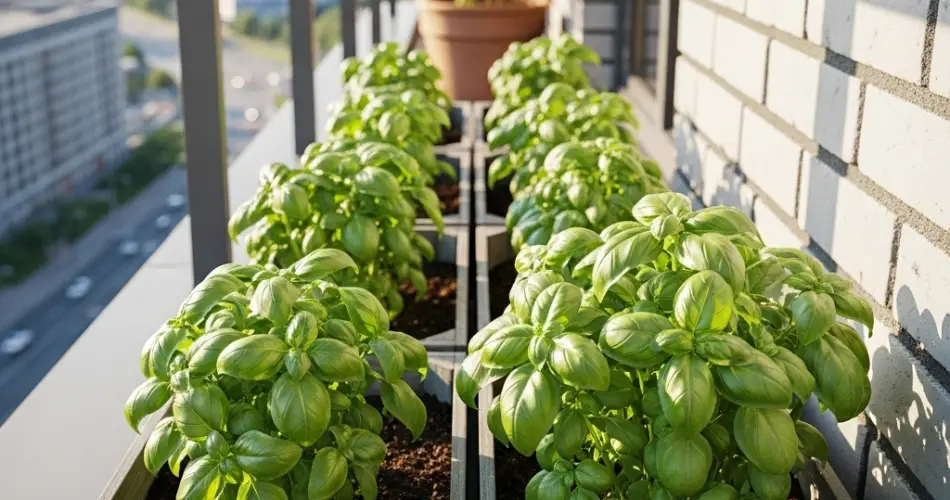Basil is one of the most beloved herbs for home gardeners. Its sweet, spicy aroma and versatile flavor make it a favorite for cooking—especially in Mediterranean and Asian dishes. While basil is often grown in pots, it can also thrive beautifully in wooden crates, which provide ample space for roots and allow for easy drainage. If you have a balcony and want a continuous supply of fresh basil, crate gardening is a simple and rewarding method.
Whether you’re a beginner or an experienced grower, cultivating basil in crates offers both convenience and productivity. It’s ideal for sunny balconies, patios, and small outdoor spaces where traditional garden beds aren’t an option. Here’s how you can grow healthy, flavorful basil right from your balcony using nothing more than a wooden crate and a few basic supplies.
Why Choose Crate Gardening for Basil?
Crate gardening has several advantages, especially when it comes to growing herbs like basil:
-
Space-efficient: Perfect for balconies, patios, or rooftops where space is limited.
-
Good drainage: Wooden crates allow water to flow out easily, preventing root rot.
-
Air circulation: Basil thrives with good airflow around the stems and leaves.
-
Scalable: You can grow one or several basil plants depending on crate size.
-
Portable: Crates can be easily moved to chase the sun or avoid bad weather.
With the right setup, basil can flourish in crates from early spring through late summer—and even longer in warm climates.
Materials Needed
To start your basil crate garden, gather the following:
-
A wooden crate (untreated wood preferred for food safety)
-
Landscaping fabric, hessian, or breathable cloth (to line the crate)
-
Scissors or a utility knife
-
High-quality potting mix
-
Organic compost or worm castings
-
Basil seeds or young basil transplants
-
Watering can or spray bottle
Optional: small pebbles for extra drainage, and mulch to retain moisture.
Preparing the Crate
-
Line the crate: Use breathable fabric like landscape cloth or burlap to line the inside of the crate. This holds the soil in place while allowing excess water to drain.
-
Add drainage material (optional): Place a layer of small pebbles at the bottom to further improve drainage.
-
Fill with soil: Mix potting soil with compost or worm castings. Basil prefers nutrient-rich, well-draining soil. Fill the crate, leaving about 2 inches of space at the top.
-
Moisten the soil: Lightly water the soil before planting to ensure even moisture.
Planting Basil
You can start basil from seeds or transplants, depending on your preference and growing season.
-
From seed: Sow seeds ¼ inch deep and space them about 4–6 inches apart. Cover lightly with soil and keep the surface moist until germination (usually 5–10 days).
-
From seedlings: If using transplants, dig small holes and space the seedlings 6–10 inches apart. Gently firm the soil around each base and water lightly.
Place the crate in a location that receives at least 6 hours of full sun daily. Morning sunlight is best for basil, as it dries dew and minimizes fungal problems.
Caring for Basil in Crates
Once planted, basil needs consistent care to thrive:
-
Watering: Basil likes moist but not soggy soil. Water when the top inch of soil feels dry. In warm weather, you may need to water daily.
-
Fertilizing: Apply a diluted liquid fertilizer or compost tea every 2–3 weeks during active growth.
-
Mulching: Add a thin layer of mulch (like straw or shredded leaves) to help retain moisture and regulate soil temperature.
-
Pinching: Pinch off the top sets of leaves regularly to encourage bushy growth and delay flowering. Always remove flower buds to prolong leaf production.
Harvesting Basil
You can begin harvesting once plants are about 6–8 inches tall.
-
Snip leaves or stems using scissors or your fingers, taking no more than one-third of the plant at a time.
-
For best flavor, harvest in the morning before the sun gets too hot.
-
Frequent harvesting helps the plant stay productive and prevents it from becoming woody.
You can use fresh basil in salads, sauces, teas, and more—or dry or freeze the leaves for future use.
Troubleshooting Common Issues
-
Yellowing leaves: Often caused by overwatering or nutrient deficiency. Check soil moisture and consider adding compost.
-
Leggy growth: Typically due to low light. Move the crate to a sunnier spot.
-
Aphids or whiteflies: Spray with soapy water or neem oil to control pests.
Basil is relatively easy to grow when it receives adequate sunlight, consistent watering, and regular harvesting.
Final Thoughts
Balcony crate gardening is a fantastic way to grow basil right outside your kitchen door. It’s simple, sustainable, and highly rewarding—offering fresh herbs at your fingertips throughout the growing season. With a wooden crate, quality soil, and a sunny spot, you can enjoy fragrant, flavorful basil whether you’re in a city apartment or a small home with limited outdoor space. Give this method a try and elevate your cooking with freshly picked basil all season long.



